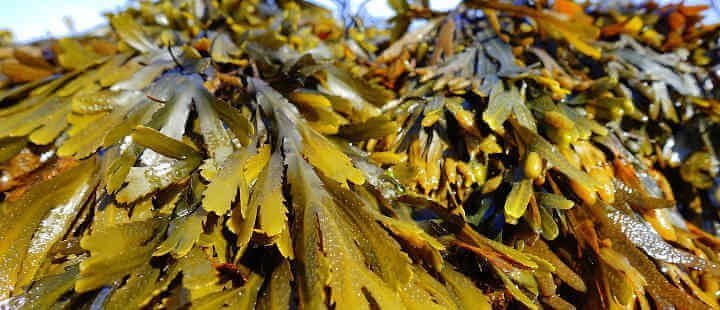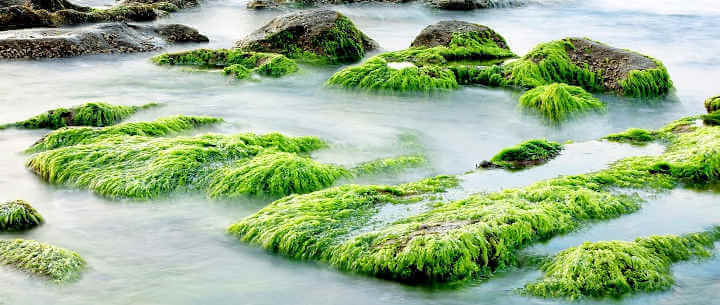Seaweed is for plants like chocolate is for us. It is a growth enhancer that enhancing the enzymatic activity of the crop.
What is seaweed?
The seaweed is organisms similar to plants living in seawater. It is also known as “macroalgae and kelp”. They belong to the protist kingdom.
Algae are eukaryotic organisms, which means they contain chloroplasts and have the ability to perform oxygenic photosynthesis to get their own energy. The algae discarded on the beaches are a source of natural fertilizer and animal foods.
Here’s I have explained how to extract seaweed and use it as a fertilizer. Moreover, I also have added the types of seaweed and their benefits that help you to know which one is suitable for which purposes.
Quick Pick: Our Recommended Best Organic Seaweed Fertilizer for Plants –
Why Seaweed Is Important for Organic Gardening?
Do you want to know the best part of the seaweed fertilizer? Seaweed doesn’t need to decompose to benefit the plant-like other organic amendments. Seaweed is always ready to provide plant nutrients. Just you have to know how to use it on plants.
Let’s have a look:
why we should use seaweed as fertilizer?
Seaweed Fertilizer Benefits In Agriculture
Using seaweed in the garden is beneficial for plants as well as your health. Seaweed contains easily decomposable organic matter and other amendments that improve the structure of the soil. It also contains:
- Nitrogen – 2%;
- Potash – 2 To 3%;
- Phosphorus – 0.3%;
- Calcium – 2%;
- Magnesium – 1%;
- Sulfur – 1 To 8%;
- Sodium – 5%.
Algae also improve the soil’s ability to retain water and promotes soil microbial life. It synthesizes phytohormones that play a vital role to promote plant growth. Finally, they stimulate as elicitors; the defense mechanisms of plants against aggressors and stress (cold, hail, drought). Now let’s see the effects of seaweed on plants, soil, and other components.
Effects on the Plant
- It Stimulates and accelerates the germination of seeds.
- Increases the size of tubers and facilitates their development.
- Act as activator and initiator of root growth.
- Improves and increases crop production.
- It allows a greater homogeneity in the size of the fruits.
- Source of phytoalexins (the natural defenses of plants).
- Increases the ability to capture nutrients provided in the fertilizer.
- Reduction of the aging of the plant or crop.
- Increases resistance to drought, salinity, and stress, such as potassium.
- Antioxidant action, being a precursor of natural hormones for plants.
- Positive effect on flowering and fruit set.
Effects on the Soil
- Maintain soil PH
- Increase the availability of macronutrients and micronutrients.
- Stabilizing effect of the soil structure.
- Work as an activator of the microorganisms present in the soil.
- Keep the soil moisture and prevent the weed growing.
Basically, kelp fertilizer promotes plants as like as plant food. It acts as a trigger or enhancer in nutrient assimilation. In the soil, it also improves the physical properties of the soil, such as moisture retention, cellulose, or source of food for positive bacteria and microorganisms.
How to Use Seaweed in Garden?

Gardens like to use seaweed in their garden in many ways. Here are the few ways to use seaweed in the garden:
Seaweed as Organic Mulch
Collect the seaweed, Rinse out to remove excess salt, and use it for organic mulch.
Seaweed Composting
Put the seaweed in your compost pile and let the microorganisms work. When the seaweed turns brown, you will get a richer compost for your garden.
Make Liquid Fertilizer
It is one of the best ways to use seaweed as fertilizer. I have discussed below how to make seaweed liquid fertilizer.
DIY: How to Make Liquid Seaweed Fertilizer for Garden?
Steps
- First, you have to collect the seaweed.
- Rinse and wash out the seaweed to remove the excess salt.
- Place the collected seaweed in a bucket.
- Now pour water in the bucket and make sure that seaweed sink into the water.
- Leave it in a cool place for a few weeks that it decomposed successfully.
- Filter the mixer and collected the seaweed fertilizer.
- Mix the final mixer and water with the ratio of 1:1
- Feed the fertilizer by pouring it on the base of the plant.
The longer it decomposes, the more concentrate tea liquid fertilizer you will get. Consider this before making kelp fertilizer. Also, never apply too much to the plant.
Harvest Seaweed in the Spring and Use It as Fertilizer in the Autumn
Fucus and laminaria are large, thick brown algae that need to be composted before spreading.
- Harvest brown algae in April-May on the beach.
- Form windrows (heaps) of 50 to 100 cm maximum height in a low point of the garden and wash it to get rid of sea salt. Leave it for decompose.
- Spread the seaweed in autumn on the plots not exceeding20 to 30 tons/ha, or 2-3 kg / m². Incorporate them superficially or leave them on the surface as “mulching”.
Collect Green or Red Algae for Rapid Spreading
It is also possible to pick up green or red algae and use them quickly in the garden.
- You can spread green algae such as sea lettuce ( Ulva Lactuca ) for their magnesium content. Use mulch less than 5 cm thick at the base of flowering shrubs and fruit trees.
- You can also make liquid fertilizer and spray this on the foliage or pour it on the seedlings without drowning them: it repels the aphids, the mites, and protects the leaves of the late blight or the botrytis.
Seaweed Extract As Biostimulants
What Is Seaweed Extracts?
Seaweed extracts are the products obtained from the chemical or physical extraction of seaweed. Seaweed extracts are one of the best biostimulants in the market.
What are biostimulants?
It is any product that contains nutrients, compounds, or microorganisms. When it applied in plants or in the rhizosphere, improve the development of the crop, vigor, yield, and quality by stimulating natural processes that benefit growth and responses to abiotic stress.
How to Make Seaweed Extract?
Seaweed (Algae) Extract Benefits
You may already know how important the seaweed extracts as biofertilizer. Thereafter, Here is a list of the benefits of the algae extracts?
- Vigorous growth: Branches grow along and increase in diameter.
- Stronger plants: The roots acquire greater length and branching.
- It induces natural sprouting.
- Increased absorption of mineral elements to the soil.
- Remarkable resistance to climatic effects: such as frost, strong heat, dryness, and in general, greater resistance to pest attacks.
- It helps to overcome the post-transplant crisis.
- It enhances the action of fungicides.
- Increase of the salable production: With uniformity in the size of the fruit.
Recommended Standard Doses of Seaweed Extracts
- Fruit trees:100-300 cc/hl (foliar application). 5 L / ha applied in irrigation.
- Vegetables in general: 100-200 cc / hl (foliar application). 5 L / ha applied in irrigation.
- Seedbeds: 150 cc/hl (foliar application), when the plant reaches 10 cm high.
- Lawn: 200-400 cc/hl (foliar application), at the beginning of spring.
- Olivegrove: 150-300 cc / hl (foliar application). 5 L / ha in irrigation.
- Vine: 200-250 cc/hl (foliar application), 5-8 L / ha in irrigation, for the beginning of sprouting, flowering or fruit set.
How to Use Seaweed Extract for Organic Garden?
Steps
- Take 1 liter of water in a container.
- Add 1 tablespoon of seaweed extract and mix well.
- Pour the seaweed solution in a spray bottle.
- Spray the foliage or directly feed the soil.
Read the manufacturer’s instructions. Generally, they mention the doses. You can also buy granulate, dried seaweed fertilizer for plants.
FAQs
#Is seaweed alkaline?
Yes! most of the seaweed is alkaline in nature. It can reduce soil pH and increase microbial activities that help to improve soil health as well as plant health.
Different Types of algae

We will classify the algae in seven main types, each with its different sizes, colors, and functions.
- Green algae (Chlorophyta)
- Red algae (Rhodophyta)
- Brown algae (Phaeophyta)
- Green-yellow algae (Xanthophyta)
- Golden algae and diatoms (Chrysophyta)
- Fire Algae (Pyrrophyta)
- Euglenide algae (Euglenophyta)
All of them belong to the protist kingdom and are usually extended throughout an aquatic habitat. They can live in different environments, such as saltwater, freshwater, wet soils, and even on rocks.
Some of these algae are single-celled, microscopic in size, and can form colonies, while other species are multicellular and they are the true marine forests.
Description of the Types of Algae
1 – Green Algae:
Most green algae are located mainly in freshwater, although some species are also found in the sea.
This type of algae has cell walls constituted by cellulose, with the presence of one or two flagella and several chloroplasts.
2 – Red Algae:
Red algae usually found in tropical seawater, especially in reef and coral areas.
Their cells lack flagella and centrioles, however, their cell walls contain cellulose and a large amount of different carbohydrates.
3 – Brown Algae:
Brown algae are one of the largest algae species in the world that are distributed throughout the oceans.
They contain different anchor tissues, air pockets to float, stems, and gametes for sexual reproduction.
4 – Yellow Green Algae:
Yellow-green algae are also known as greenish yellow algae. These are unicellular organisms, whose membrane is formed by cellulose and silica and contain one or two flagella to get moving. We can find them in salt water and even outside, in moist soils.
5 – Golden Algae and Diatoms:
Golden algae and diatoms are undoubtedly the most widespread types of unicellular algae that include thousands of different species.
We find them in both fresh and saltwater. The golden algae are known as microscopic plankton.
6 – Fire Algae:
Fire algae are usually found in the oceans, but they can also appear in is known.
We can divide fire algae into two distinct classes:
The Dinoflagellates, which form red tides, and that some species have a luminescence capacity that showing the sea is on fire at night. That is why it name fire algae. It is highly poisonous, being able to ruin the fishing where they usually proliferate.
7 – Euglenid Algae:
We find them in both fresh and saltwater. This type of algae has no cell walls, however, they are protected by a layer of proteins very similar to the animal cell wall.
It has a great capacity to create symbiotic relationships with green algae.
Conclusion
Seawood may be the alternative to the synthetic and other chemical plant foods. It contains all the ingredients that plant needs. I hope you already have learned the seaweed tea benefits. So what are you waiting for? Collect the seaweed and use it as fertilizer.
Your plant will thank you for this.
